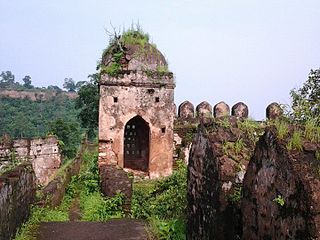
Nagpuri is an Indo-Aryan language spoken in the Indian states of Jharkhand, Chhattisgarh, Odisha and Bihar. It is primarily spoken in the west and central Chota Nagpur plateau region. It is sometimes considered a dialect of Bhojpuri.
The region have been inhabited since the Stone Age. Copper tools from the Chalcolithic period have been discovered. This area entered the Iron Age during the mid-2nd millennium BCE.

The Palamu kila are two ruined forts located 3 k.m from Betla National Park, Latehar district on the bank of Auranga River, in the Indian state of Jharkhand. The old fort in the plains, which existed even before the Chero dynasty, was built by the King of Raksel dynasty. The original fort in the plains and the other on an adjoining hill are attributed to the kings of the Chero dynasty. The fort in the plains had defences on three sides and three main gates. The New fort was constructed by Raja Medini Ray. East India company used this fort to prison Narayan Peshwa of Tiroha and Raja Harsh dubey alias Subedar Aftab Singh mutineers of 1857.
Ranchi district is one among the twenty-four districts of the state of Jharkhand in Eastern India. This region was under the control of the Magadha Empire, then it was a part of the Mauryan Empire under Ashoka and later a part of the Gupta Empire. After the fall of the Gupta Empire a legendary king named Phanimukut established the Nagvanshi dynasty and controlled the Chota Nagpur plateau region for several centuries thereafter.
Medini Raia.k.a.Madini Rai or Madini Rao ruled from 1658 to 1674 in the Palamu region of Bengal, now in Jharkhand.

The Nagvanshis of Chotanagpur, also known as the Khokhra chieftaincy, was an Indian dynasty which ruled the parts of Chota Nagpur plateau region during the medieval and modern periods. Phani Mukut Rai, considered the first king of the dynasty, claimed to be the son of Pundrika Naga, a mythical Naga. Lal Chintamani Sharan Nath Shahdeo (1931–2014) was last ruling king of the dynasty, until the estate was merged to the Republic of India.
The Nagpuria people, also Nagpuri or Sadan, are an Indo-Aryan speaking ethnolinguistic group who are the native speakers of the Nagpuri language and natives of the western Chota Nagpur Plateau region of Indian states of Jharkhand, Bihar, Chhattisgarh and Odisha.
Sadan are the native Indo-Aryan-speaking ethnolinguistic groups of Chota Nagpur Plateau consist of Indian state of Jharkhand and neighbouring states who speak Nagpuri, Khortha and Kurmali language as their native language.
Khukhragarh was one of the capitals of Nagvanshi dynasty, who once ruled in parts of the Indian state of Jharkhand. It is located in the Bero block in the Ranchi Sadar subdivision of Ranchi district.
Durjan Shah was a Nagvanshi king in the 17th century. He had built Navratangarh fort.

Navratangarh (Doisagarh) was one of the capitals of the Nagvanshi dynasty, who ruled parts of what is now the state of Jharkhand, India. It is located in Sisai block of Gumla district. It is said that king Durjan Shah shifted his capital from Khukhragarh to Navratangarh. He constructed the fort between 1636 and 1639. The palace was a five-storeyed structure with its "water-gate" and garh-khai (moat) arrangement. It has a kiaclmy (court), a treasury house and a prison-cell with its underground dungeon. It was declared national heritage in 2009.
Ghasi Ram Mahli was an Indian Nagpuri-language poet. He was a poet under the patronage of Nagvanshi Lal Thakur of Thakurgaon. He was the first poet of the Nagpuri language, whose book was published in 1911.
Phani Mukut Rai was the first ruler of the Nagvanshi dynasty and is considered its founder in the first century CE. However, the story of Phani Mukut Rai is regarded as a myth by historians, who date the establishment of the Nagvanshi dynasty to around the fourth century CE.
Ram Shah was Nagvanshi king in the 17th century. He succeed his brother Durjan Shah and ruled from 1640 to 1663 CE. Earlier their capital was at Khukhragarh, but later they shifted to Navratangarh. He was brother of king Durjan Shah.
Yadunath Shah was a Nagvanshi king in the 18th century. His capital was at Navratangarh. He succeeded Raghunath Shah and ruled from 1690 to 1724 CE. He shifted his capital from Navratangarh to Palkot.
Gajghat Rai was Nagvanshi king in 9th century. He succeeded Gajdant Rai.
Nagpuri literature refers to literature in the Nagpuri language, the language of Jharkhand, Chhattisgarh and Odisha. The earliest literature started in the nagpuri language when the Nagvanshi king and king of Ramgarh Raj started writing poetry in the 17th century. Since then, various literature has been written. Although in the present century, Nagpuri was never considered worthy of literary development. But some dedicated writers have engaged in writing short stories, plays and poetry.
Nagpuri culture refers to the culture of the Nagpuria people, the native speakers of the Nagpuri language, which includes literature, festivals, folk song and dance. It is also referred to as the culture related to the Nagpuri language.
Jagannath Shah Deo was a Nagvanshi king in the 19th century. He succeeded Govind Nath Shah and ruled from 1822 to 1869 CE. During his reign, Kol uprising and Sepoy mutiny of 1857 happened. He was ally of British East India company. During his reign, Beniram Mehta had written the book Nagvanshavali, the genology of Nagvanshi kings in Nagpuri language which was published in 1876.




